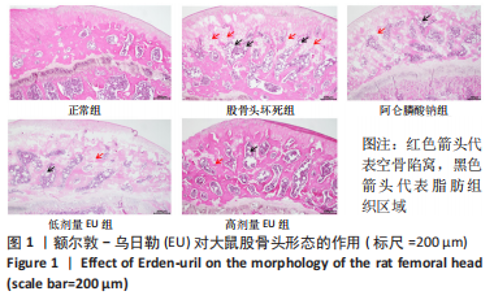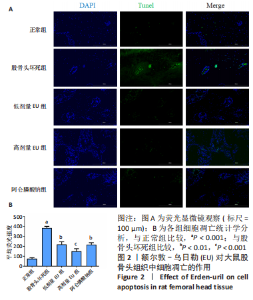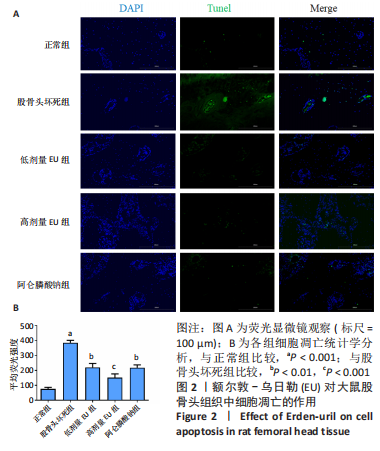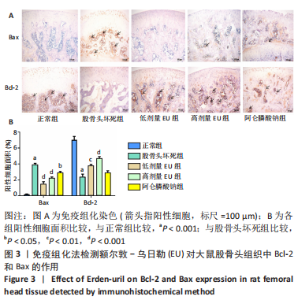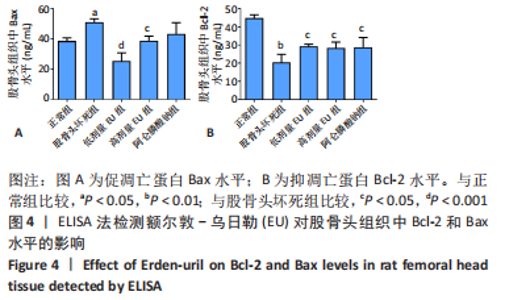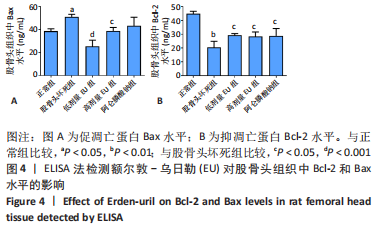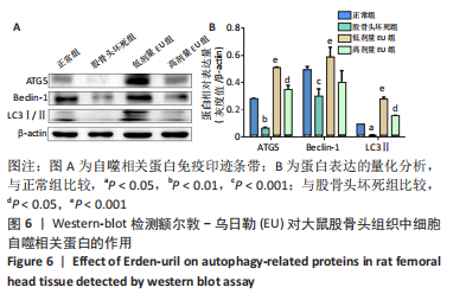Chinese Journal of Tissue Engineering Research ›› 2023, Vol. 27 ›› Issue (35): 5670-5675.doi: 10.12307/2023.854
Previous Articles Next Articles
Mechanism of Mongolian Medicine Erden-uril on avascular necrosis of the femoral head in rats
Jin Hongguang1, 2, Shi Zhuang1, Wang Huaxin1, Ni Ma2, Fu Yong2
- 1Affiliated Hospital of Inner Mongolia University for Nationalities, Tongliao 028005, Inner Mongolia Autonomous Region, China; 2Affiliated Hospital of Jiangxi University of Chinese Medicine, Nanchang 330006, Jiangxi Province, China
-
Received:2022-10-25Accepted:2022-12-13Online:2023-12-18Published:2023-06-05 -
Contact:Fu Yong, MD, Professor, Affiliated Hospital of Jiangxi University of Chinese Medicine, Nanchang 330006, Jiangxi Province, China -
About author:Jin Hongguang, Master, Associate chief physician, Affiliated Hospital of Inner Mongolia University for Nationalities, Tongliao 028005, Inner Mongolia Autonomous Region, China; Affiliated Hospital of Jiangxi University of Chinese Medicine, Nanchang 330006, Jiangxi Province, China
CLC Number:
Cite this article
Jin Hongguang, Shi Zhuang, Wang Huaxin, Ni Ma, Fu Yong. Mechanism of Mongolian Medicine Erden-uril on avascular necrosis of the femoral head in rats[J]. Chinese Journal of Tissue Engineering Research, 2023, 27(35): 5670-5675.
share this article
Add to citation manager EndNote|Reference Manager|ProCite|BibTeX|RefWorks
| [1] CHAO PC, CHIEN WC, CHUNG CH, et al. Correlation between miR-1207-5p expression with steroid-induced necrosis of femoral head and VEGF expression.Eur Rev Med Pharmacol Sci. 2019;23(7):2710-2718. [2] LI X, LI Y, LI L, et al. Overactivated autophagy contributes to steroid-induced avascular necrosis of the femoral head. Exp Ther Med. 2017;14(1):367-372. [3] WANG A, REN M, WANG J. The pathogenesis of steroid-induced osteonecrosis of the femoral head: A systematic review of the literature. Gene. 2018;671:103-109. [4] 孙亮, 刘万林, 娜日松, 等. 3-甲基腺嘌呤调控自噬基因Beclin1可降低模型兔激素性股骨头缺血坏死的发生与发展[J]. 中国组织工程研究,2019,23(15): 2391-2396. [5] MANOLAGAS SC, WEINSTEIN RS, NICHOLAS RW. Apoptosis of osteocytes in glucocorticoid-induced osteonecrosis of the hip. J Clin Endocrinol Metab. 2000;85(8):2907-2912. [6] MORIISHI T, MARUYAMA Z, FUKUYAMA R,et al. Overexpression of Bcl2 in osteoblasts inhibits osteoblast differentiation and induces osteocyte apoptosis. PloS one.2011;6(11):e27487. [7] WEINSTEIN RS, O’BRIEN CA, ALMEIDA M, et al. Osteoprotegerin prevents glucocorticoid-induced osteocyte apoptosis in mice. Endocrinology. 2011;152(9): 3323-3331. [8] WEINSTEIN R, NICHOLAS R, MANOLAGAS S. Apoptosis of osteocytes in glucocorticoid-induced osteonecrosis of the hip. J Clin Endocrinol Metab. 2000; 85(8):2907-2912. [9] ZALAVRAS C, SHAH S, BIRNBAUM M, et al. Role of apoptosis in glucocorticoid-induced osteoporosis and osteonecrosis. Crit Rev Eukaryot Gene Expr. 2003; 13(2-4):221-235. [10] ZHAN J, YAN Z, ZHAO M, et al. Allicin inhibits osteoblast apoptosis and steroid-induced necrosis of femoral head progression by activating the PI3K/AKT pathway. Food Funct. 2020;11(9):7830-7841. [11] BAI R, FENG W, LIU W, et al. Roles of osteocyte apoptosis in steroid-induced avascular necrosis of the femoral head. Genet Mol Res. 2016;15(1). doi: 10.4238/gmr.15017529. [12] LAI E, HONG C, KOK S, et al. Simvastatin alleviates the progression of periapical lesions by modulating autophagy and apoptosis in osteoblasts. J Endod. 2012; 38(6):757-763. [13] WHITEHOUSE C, WATERS S, MARCHBANK K, et al. Neighbor of Brca1 gene (Nbr1) functions as a negative regulator of postnatal osteoblastic bone formation and p38 MAPK activity. Proc Natl Acad Sci U S A. 2010;107(29):12913-12918. [14] YOUSEFI S, PEROZZO R, SCHMID I, et al. Calpain-mediated cleavage of Atg5 switches autophagy to apoptosis. Nat Cell Biol. 2006;8(10):1124-1132. [15] 白珍, 莲花. 额尔敦-乌日勒药理作用及机制研究[J].中国蒙医药(蒙),2016,11(6):4. [16] 蒙医学编辑委员会. 中国医学百科全书·蒙医学[M]. 赤峰:内蒙古科学技术出版社,1987,(蒙文版):862. [17] 宝莉莉, 宋福顺, 都格尔, 等. 蒙药额尔敦-乌日勒的研究进展[J].中国民族民间医药,2019,28(3):53-56. [18] 玉春, 阿拉坦格日乐, 特木日巴根, 等. 蒙药苏木-6治疗股骨头坏死97例临床疗效观察[J]. 中国民族医药杂志,2016,22(1):14-15. [19] WU X, YANG S, DUAN D, et al. Experimental osteonecrosis induced by a combination of low-dose lipopolysaccharide and high-dose methylprednisolone in rabbits. Joint Bone Spine. 2008;75(5):573-578. [20] 蒋玮, 曹林忠, 邬明峻, 等. 激素性股骨头坏死动物模型的建立及评价[J].中国实验动物学报,2019,27(6):799-804. [21] 谢磊, 张严, 姜自伟, 等. 引导骨再生技术结合补肾法修复大鼠股骨骨缺损[J]. 中国组织工程研究,2020,24(26):4106-4111. [22] 王哲, 李炎, 娄理想, 等. 富血小板血浆联合髓芯减压调控激素性股骨头坏死模型兔氧化应激反应[J]. 中国组织工程研究,2020,24(11):1677-1682. [23] XUE X, FENG Z, LI Z, et al. Salidroside inhibits steroid-induced avascular necrosis of the femoral head via the PI3K/Akt signaling pathway: In vitro and in vivo studies. Mol Med Rep. 2018;17(3):3751-3757. [24] FENG Z, ZHENG W, TANG Q, et al. Fludarabine inhibits STAT1-mediated up-regulation of caspase-3 expression in dexamethasone-induced osteoblasts apoptosis and slows the progression of steroid-induced avascular necrosis of the femoral head in rats. Apoptosis. 2017;22(8):1001-1012. [25] GLIMCHER MJ, KENZORA JE. The Biology of Osteonecrosis of the Human Femoral Head and its Clinical Implications: III. Discussion of the Etiology and Genesis of the Pathological Sequelae; Comments on Treatment. Clin Orthop Relat Res. 1979;(140):273-312. [26] 宋奕, 丁道芳, 李玲慧, 等. 细胞凋亡在激素性股骨头坏死机制中的研究进展[J].中国矫形外科杂志 ,2013,21(21):2163-2165. [27] LUO P, GAO F, HAN J, et al. The role of autophagy in steroid necrosis of the femoral head: a comprehensive research review. Int Orthop. 2018;42(7):1747-1753. [28] YAMAMOTO T, HIRANO K, TSUTSUI H, et al. Corticosteroid enhances the experimental induction of osteonecrosis in rabbits with Shwartzman reaction. Clin Orthop Relat Res. 1995;(316):235-243. [29] XU X, WEN H, HU Y, et al. STAT1-caspase 3 pathway in the apoptotic process associated with steroid-induced necrosis of the femoral head. J Mol Histol. 2014; 45(4):473-485. [30] LV W, YU M, KONG P, et al. Total flavonoids of Rhizoma drynariae ameliorate steroidinduced avascular necrosis of the femoral head via the PI3K/AKT pathway. Mol Med Rep. 2021;23(5):345. [31] CUI D, ZHAO D, WANG B, et al. Safflower (Carthamus tinctorius L.) polysaccharide attenuates cellular apoptosis in steroid-induced avascular necrosis of femoral head by targeting caspase-3-dependent signaling pathway. Int J Biol Macromol. 2018;116:106-112. [32] CUI D, ZHAO D, HUANG S. Structural characterization of a safflower polysaccharide and its promotion effect on steroid-induced osteonecrosis in vivo.Carbohydr Polym. 2020;233:115856. [33] HUANG W, JIN S, YANG W, et al. Protective effect of Agrimonia pilosa polysaccharides on dexamethasone-treated MC3T3-E1 cells via Wnt/β-Catenin pathway. J Cell Mol Med. 2020;24(3):2169-2177. [34] HAN X, ZHANG P, JIANG R, et al. Explore on the effect of ATF6 on cell growth and apoptosis in cartilage development. Histochem Cell Biol. 2014;142(5):497-509. [35] KIM J, CHEE W, YABUTA N, et al. Atg5-mediated autophagy controls apoptosis/anoikis via p53/Rb pathway in naked mole-rat fibroblasts. Biochem Biophys Res Commun. 2020;528(1):146-153. [36] PENG P, NIE Z, SUN F, et al. Glucocorticoids induce femoral head necrosis in rats through the ROS/JNK/c-Jun pathway. FEBS Open Bio. 2021;11(1):312-321. [37] ZHU L, CHEN J, ZHANG J, et al. Parathyroid Hormone (PTH) Induces Autophagy to Protect Osteocyte Cell Survival from Dexamethasone Damage. Med Sci Monit. 2017;23:4034-4040. [38] ZHU Y, ZHAO L, LIU L, et al. Beclin 1 cleavage by caspase-3 inactivates autophagy and promotes apoptosis. Protein Cell. 2010;1(5):468-477. [39] WANG X, GONG L, HUANG J, et al. Pinocembrin alleviates glucocorticoid-induced apoptosis by activating autophagy via suppressing the PI3K/Akt/mTOR pathway in osteocytes. Eur J Pharmacol. 2020;880:173212. [40] HUANG Z, WANG Q, ZHANG T, et al. Hyper-activated platelet lysates prevent glucocorticoid-associated femoral head necrosis by regulating autophagy. Biomed Pharmacother. 2021;139:111711. [41] FLORENCIO-SILVA R, SASSO GRS, SASSO-CERRI E, et al. Effects of estrogen status in osteocyte autophagy and its relation to osteocyte viability in alveolar process of ovariectomized rats. Biomed Pharmacother. 2018;98:406-415. [42] HAN J, CHAI Y, ZHANG X, et al. αGujiansan Ameliorates Avascular Necrosis of the Femoral Head by Regulating Autophagy via the HIF-1/BNIP3 Pathway.Evidence-based complementary and alternative medicine: eCAM. 2021;2021:6683007. [43] LIU S, HUANG Y, WANG C, et al. Epimedium protects steroid-induced avascular necrosis of femoral head in rats by inhibiting autophagy. Exp Ther Med. 2018; 16(6):5047-5052. |
| [1] | Yang Yifeng, Ye Nan, Wang Lin, Guo Shuaicheng, Huang Jian. Signaling pathway of dexmedetomidine against ischemia-reperfusion injury [J]. Chinese Journal of Tissue Engineering Research, 2024, 28(9): 1464-1469. |
| [2] | Yue Yun, Wang Peipei, Yuan Zhaohe, He Shengcun, Jia Xusheng, Liu Qian, Li Zhantao, Fu Huiling, Song Fei, Jia Menghui. Effects of croton cream on JNK/p38 MAPK signaling pathway and neuronal apoptosis in cerebral ischemia-reperfusion injury rats [J]. Chinese Journal of Tissue Engineering Research, 2024, 28(8): 1186-1192. |
| [3] | Zhao Garida, Ren Yizhong, Han Changxu, Kong Lingyue, Jia Yanbo. Mechanism of Mongolian Medicine Erden-uril on osteoarthritis in rats [J]. Chinese Journal of Tissue Engineering Research, 2024, 28(8): 1193-1199. |
| [4] | Wang Ji, Zhang Min, Li Wenbo, Yang Zhongya, Zhang Long. Effect of aerobic exercise on glycolipid metabolism, skeletal muscle inflammation and autophagy in type 2 diabetic rats [J]. Chinese Journal of Tissue Engineering Research, 2024, 28(8): 1200-1205. |
| [5] | Zhou Bangyu, Li Jie, Ruan Yushang, Geng Funeng, Li Shaobo. Effects of Periplaneta americana powder on motor function and autophagic protein Beclin-1 in rats undergoing spinal cord hemisection [J]. Chinese Journal of Tissue Engineering Research, 2024, 28(8): 1223-1228. |
| [6] | Sheng Siqi, Xie Lin, Zhao Xiangyu, Jiang Yideng, Wu Kai, Xiong Jiantuan, Yang Anning, Hao Yinju, Jiao Yun. Involvement of miR-144-3p in Cbs+/- mouse hepatocyte autophagy induced by high-methionine diet [J]. Chinese Journal of Tissue Engineering Research, 2024, 28(8): 1289-1294. |
| [7] | Liu Qiwei, Zhang Junhui, Yang Yuan, Wang Jinjuan. Role and mechanism of umbilical cord mesenchymal stem cells on polycystic ovary syndrome [J]. Chinese Journal of Tissue Engineering Research, 2024, 28(7): 1015-1020. |
| [8] | Pan Xiaolong, Fan Feiyan, Ying Chunmiao, Liu Feixiang, Zhang Yunke. Effect and mechanism of traditional Chinese medicine on inhibiting the aging of mesenchymal stem cells [J]. Chinese Journal of Tissue Engineering Research, 2024, 28(7): 1091-1098. |
| [9] | Huang Yuxin, Liang Wenzi, Chen Xiuwen, Ni Na, Zhao Yinglin, Lin Changmin. Role of autophagy in hair regeneration [J]. Chinese Journal of Tissue Engineering Research, 2024, 28(7): 1112-1117. |
| [10] | Shen Feiyan, Yao Jixiang, Su Shanshan, Zhao Zhongmin, Tang Weidong. Knockdown of circRNA WD repeat containing protein 1 inhibits proliferation and induces apoptosis of chondrocytes in knee osteoarthritis [J]. Chinese Journal of Tissue Engineering Research, 2024, 28(4): 499-504. |
| [11] | Chen Zepeng, Hou Yonghui, Chen Shudong, Hou Yu, Lin Dingkun. Tauroursodeoxycholic acid treats spinal cord injury by reducing apoptosis of spinal cord neurons under glucose and oxygen deprivation [J]. Chinese Journal of Tissue Engineering Research, 2024, 28(4): 528-534. |
| [12] | Xue Jingwen, Wang Fangfang, Zhang Xin, Pang Ruifeng, Wang Xiaoye, Ma Xiaoru. Effect of ganoderma spore on mitochondrial autophagy and apoptosis in testicular tissue of diabetic rats [J]. Chinese Journal of Tissue Engineering Research, 2024, 28(4): 562-568. |
| [13] | Yan Binghan, Li Zhichao, Su Hui, Xue Haipeng, Xu Zhanwang, Tan Guoqing. Mechanisms of traditional Chinese medicine monomers in the treatment of osteoarthritis by targeting autophagy [J]. Chinese Journal of Tissue Engineering Research, 2024, 28(4): 627-632. |
| [14] | Duan Yanzhe, Hua Jianlin, Ding Zhibin, Jiang Nan, Song Lijuan, Yan Yuqing, Ma Cungen. Visual analysis of the effect of apoptosis on ischemic stroke [J]. Chinese Journal of Tissue Engineering Research, 2024, 28(26): 4145-4150. |
| [15] | Ma Lingju, Wang Lexin, Chi Hongyang, Zhang Jingwen, Peng Hongjian, Gao Chunlan, Jiang Yideng, Huang Hui, Yang Li, Ma Shengchao. Role of METTL3 in homocysteine-induced autophagy in mouse islet beta cells [J]. Chinese Journal of Tissue Engineering Research, 2024, 28(26): 4221-4225. |
| Viewed | ||||||
|
Full text |
|
|||||
|
Abstract |
|
|||||
